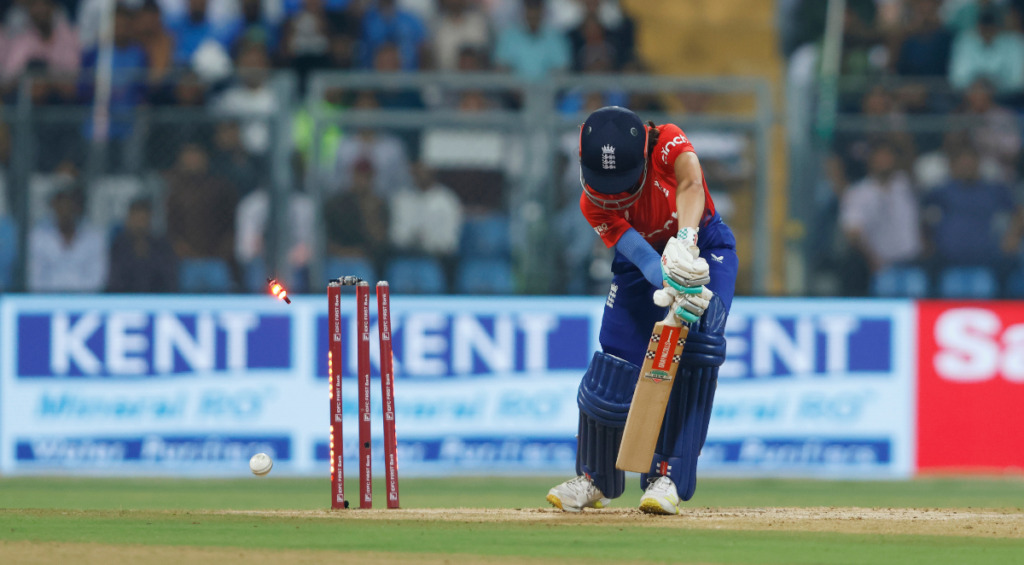
A series win in India is an important tick in England’s development, but several crosses next to their batting in the series should give them more to think about for the schedule ahead.
England were bundled out for 126 in the final match of the series in Mumbai, their effort only somewhat rescued by Heather Knight’s battling half-century. Once again, early wickets meant their innings got off to a frantic start. Sophia Dunkley was dismissed for the third consecutive time by Renuka Singh Thakur, throwing her hands at the ball and giving a simple catch to backward point.
While not as obviously ugly, it was a similar style of dismissal to how she was out in the second ODI, frustrated at being unable to find the boundary, attempting the big shot and mis-executing. While Dunkley wasn’t the only one who struggled against Thakur (seven wickets in the series at 10.83), her difficulties were the most pronounced. Dunkley has only passed 30 in two of her 11 T20I innings this year. With Beaumont’s absence from the T20I squad becoming more and more difficult to explain, keeping Dunkley in at the top of the order is becoming harder to sustain.
In each of the three T20Is, Thakur took two wickets inside her opening two overs leaving England’s middle order exposed early. While a 138-run partnership from Danni Wyatt and Nat Sciver-Brunt steadied things the first time around, there was no such stability to fall back on after that.
Yesterday (December 9), having bowled India out for 80, Sciver-Brunt was out with 19 still required to win. Alice Capsey, Amy Jones and Freya Kemp were all then dismissed within the next 16 balls, leaving England 73-6. It was far from the calm, clinical chase of a side confident in their ability to play both the conditions and match situation. Capsey was out backing away from her stumps trying to hit over cover, while Jones and Kemp fell to consecutive deliveries from Deepti Sharma.
Setting a total today (December 10), almost every box was ticked on the batting warning system. Four golden ducks fell in England’s innings, one of them Maia Bouchier in the first over of the game. They were two down within the first powerplay, lost four wickets for three runs in the middle and were bowled out from the last ball of the innings.
It’s important that England made three changes to their XI for the final T20I. They rested Sciver-Brunt and Wyatt and brought in Bouchier and Bess Heath, with Dani Gibson also coming in. Between them, they scored one run and faced seven balls. Who England rely upon to score their runs, particularly in less familiar environments for their younger players, needs addressing.
England’s players aged 30 and over averaged 31.78 at a strike rate of 138.16 in the series, with those who are 25 and younger averaging 6.25 at a strike rate of 83.33. There are no players in between the two age groups. While it’s the senior player’s job to deliver that stability, the size of the gap is concerning, to say the least. There’s also something to be said for experience in Indian conditions. Most of England’s senior batters featured in the WPL last year and have been on international tours to India before. But with a T20 World Cup in Bangladesh on the horizon, that the younger players adapt to that steep learning curve is essential.
Before the series, England’s commitment to addressing their well-documented issues against spin, saw them take six batters on a spin-camp to Mumbai. Heath, Kemp and Gibson were all on that trip. All of their dismissals in this series fell to spinners, and they collectively scored six runs in the series in five individual innings.
Speaking in the press conference after the final match of the series, Jon Lewis acknowledged how tough England’s younger batters had found the conditions. “Between now and the World Cup in Bangladesh, we have about 18 games,” he said. “None of them are in the subcontinent so coming here to prepare is really important… similar skills will be required and a similar understanding of how to play slow bowlers in particular.
“I thought the girls really stood up to that challenge over the first two games and then the players that came in have had an exposure and they’ll go back to their coaches and be like, okay how can I get better at playing these conditions? So we’ll continue to develop our players and our team, but to beat India in India doesn’t happen very often.”
With a similar set of batters likely to play the Test match next week, how they tackle the challenge of those conditions over four days is a bigger question. But the weaknesses exposed by India, despite the scoreline, have brought the question marks over their batting depth and consistent robustness into sharper focus.
Subscribe to the Wisden Cricket YouTube channel for post-match analysis, player interviews, and much more.
The post Despite series win, England’s batting warning system is flashing ‘red’ appeared first on Wisden.
from Wisden https://ift.tt/szcqLOC



0 Comments